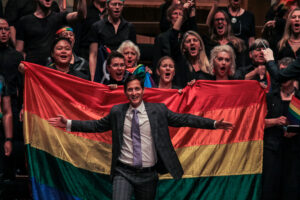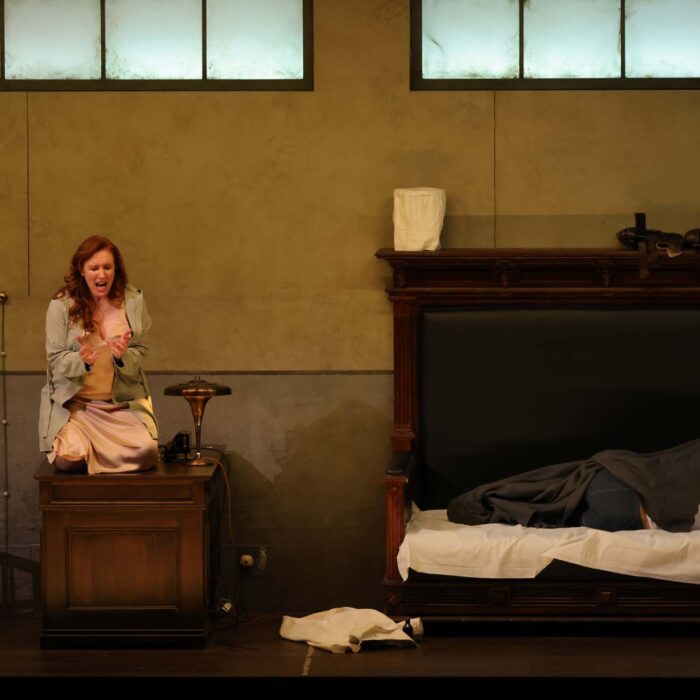
The Person Behind The Opera, Pt. 2: Harvey Milk
By John VandevertPhoto Credit: Lisa Chanell
As Pride 2025 comes to a close, it’s helpful to remember the many voices which contributed to the liberated voicing of the LGBT+ community that we’ve heard this month. From the ripples caused by Stonewall, embodied sexual openness and its celebration in many forms, to dramatic stories of frustrated love, opera has become a preeminent venue for the public discussion of LGBT+ history. Given recent events concerning performance venues within the United States, the stories from marginalized communities are in vital need of not only uplift but remembrance as their place in history is under threat, now more than ever.
For part two of The Person Behind The Opera, a new five-part series exploring five operas based on real-life figures who all faced different forms of opposition and hardship during their time, we will be looking at American composer Stewart Wallace‘s second opera, ‘Harvey Milk.’ With its development beginning in the mid-1990s, the opera’s premiere was a failure. Flash to its 2020 and the work, in a two-act form, was revived for the first time by the Opera Parallèle in San Francisco, California. It was performed again in 2022 by the Opera Theatre of Saint Louis.
With over 70 roles, the opera succeeded in bringing attention to Harvey Milk (1930-1978). Born in New York, he’s best known for being one of the leaders of the second wave of gay rights movement during the 1960s-1970s at a time of unprecedented antagonism. Campaigning for mayor in 1973, he became city supervisor in 1977 and in 1978, helped pass the first anti-discrimination laws on grounds of sexual orientation. From 1973 to 1978, Milk made huge strides for the gay community in California and elsewhere. However, on November 27, 1978, California mayor George Moscone and Milk were shot by Dan White, fatally killing them both and sparking mass riots after White’s light sentence of only seven years on voluntary manslaughter.
The life and career of Harvey Milk is complicated and multi-faceted. Having begun his political career because of the lack of initiative from others, a timeless story, by the mid-1970s, he was being considered by the political milieu as a real contender and upon George Moscone‘s appointment as mayor, gay rights advocacy only grew. Following the attempted assassination of Gerald Ford, thwarted by gay veteran Oliver Sipple, in 1976 Milk was appointed onto the Board of Permit Appeals by Moscone but fired him, technically, as Milk had decided to run for the California State Assembly, although losing by a narrow margin.
In fall of 1976, Milk campaigned to be District 5’s supervisor in a new system of neighborhood elections. Running against flagrantly homophobic individuals like Anita Bryant and gay professionals like Rick Stokes, Milk won the election, marking a n important checkpoint in his life. Also elected as supervisor, White would vote against everything Milk wanted and vice versa. The apex of Milk’s career was from November 7-27, those twenty days marked by the failed attempt to ban gay men and women from working in public schools, referred to as ‘Proposition 6‘ on the 1978 California state ballot. Initiated by homophobe John Briggs (1930-2020), it failed (58% to 42%) but effectively sealed Milk’s fate as ire with White was growing.
Only 10 months into his term, on November 10, 1978, White resigned as the salary was proving insufficient to raise his family, not to mention the growing concerns over gentrification which was raising housing costs. Soon thereafter, he tried to reverse this only to have it rejected by Moscone as his district was now far more liberal than conservative. Having lost his political power and under considerable financial strain, this brought about due to his own actions (voting no on ‘Proposition 13‘), the drama was reaching its conclusion. By November 21, White’s resignation was confirmed and on the morning of November 28, before a scheduled press conference, in a series of events, the desperate White killed Moscone, then Milk, and later fled.
Symbolizing far more than Harvey Milk but the forthright courage we all must show in the face of egregious mistreatment, Wallace’s opera demonstrates that we are all capable of speaking truth to power, despite the many roadblocks in our midst.
Watch
Categories
Special Features

